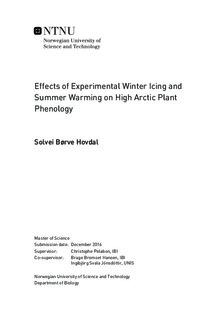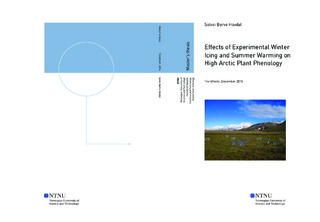| dc.description.abstract | Climate change is expected to have pronounced effects in the Arctic, causing increased temperatures and changes in winter precipitation patterns. For instance, extreme winter rain events often result in ground ice formations covering the vegetation. These alterations in temperature and precipitation are expected to cause phenological changes in high Arctic plant species by, for instance, altering plant growing conditions or the length of the growing season. We examined phenological responses (reproductive and vegetative) to climate change, in a full factorial field experiment in high Arctic Svalbard (78°N). Here, we simulated an extreme mid-winter rain on snow event by experimentally adding water and encapsulating the vegetation in solid ice during winter 2015/2016, and increased summer temperatures by open top chambers. During summer 2016, we investigated the effect of treatments (warming, icing and the combination of warming and icing) on the phenology of key vascular species, Salix polaris, Bistorta vivipara, Poa arctica, Alopecurus borealis and Luzula confusa. The icing treatment caused on average three days delay in spring melt and had a general tendency to delay reproductive phenology with the approximately same magnitude, yet we have large variation between species and phenophases. This overall delay tended to diminish through the season. In contrast, the warming treatment advanced reproductive phenology with about 2 8 days, across all species over the summer, with pronounced effect on phenophases involving floral development and seed maturation. The combined icing and warming treatment advanced phenology to a lesser extent than the warming treatment alone, indicating that warmer temperatures mitigate the effect of delayed spring onset due to later melting time. We found no treatment effect on vegetative phenology. Phenological changes can have consequences for plant fitness and may affect key ecosystem components, in addition to trophic interactions. By documenting phenological alterations in key Arctic tundra species as a consequence of warmer temperatures and ice encapsulation, this study gives insight into how high Arctic tundra vegetation could respond to the predicted future climate change. Further investigations on possible delayed phenological effects and other plant traits, such as seed germinability, are needed in order to further understand the effect of climate change on fitness. | |

